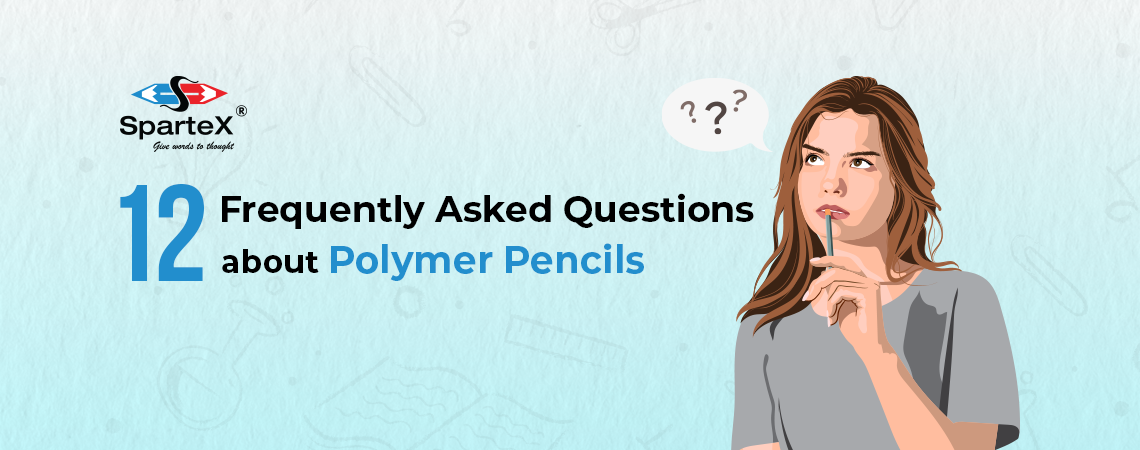Pencils may seem like simple tools, but behind their wooden shells lies a fascinating world of craftsmanship, chemistry, and creativity. From school desks to artist studios, pencils have played an essential role in communication, design, and self-expression for centuries. Yet, many people don’t know what actually goes into making a pencil, how the grading system works, or why they keep breaking mid-sketch.
Whether you’re a curious student, an artist, or simply someone who appreciates everyday essentials, this blog will answer the most common (and some uncommon) questions about pencils—covering everything from materials to longevity, usability, and care.
To help buyers make the right choice, this blog compiles the most frequently asked questions about polymer pencils.
1. What is the raw material for Polymer pencils?
The primary raw material for polymer pencils is graphite, which is mixed with clay to create the writing core, often referred to as “lead.” The outer casing is typically made of cedar wood, known for its durability and smooth sharpening. Additional materials include lacquer for varnishing, adhesives for bonding, and sometimes erasers attached with metal ferrules.
2. How is lead put into a pencil?
Despite its name, the “lead” in pencils is actually a mix of graphite and clay. During manufacturing, thin rods of this mixture are baked to harden. The wooden pencil casing is made in two halves, with a groove carved into each. The graphite rod is laid into the groove, and the two halves are glued together, then shaped and finished.
3. What type of pencils are used in school?
In schools, the most commonly used pencils are HB grade, which offer a good balance between hardness and darkness. They are ideal for writing, easy to erase, and produce a consistent line. These pencils are usually hexagonal or round in shape for comfortable grip and come pre-sharpened or with erasers attached.
Looking for polymer pencils to buy in bulk?
Request Quote4. What does the “HB” label on a pencil indicate?
The “HB” on a pencil stands for Hard Black. It indicates a medium level of both hardness and blackness, making it suitable for everyday use. The “H” refers to the hardness of the graphite, and the “B” refers to how black or soft it is. HB sits right in the middle of the pencil grading scale.
5. How long can a typical pencil line be if used continuously?
A standard pencil can draw a continuous line of up to 45 miles (about 70 kilometers) if used without sharpening. It can also write around 45,000 words before it’s completely used up. Of course, real-world usage varies depending on pressure, writing surface, and sharpening frequency.
6. What are the pencils varnished with?
Pencils are varnished with non-toxic, water-based or solvent-based lacquers that give them their finished appearance and protect the wood. The varnish can be glossy or matte and often includes color pigments. Premium pencils may have multiple coats for extra durability and a smoother touch.
7. Why do the pencils have different shapes?
Pencils come in shapes like hexagonal, round, and triangular to cater to different grip preferences and prevent rolling. Hexagonal pencils are common because they’re easy to hold and won’t roll off desks. Triangular pencils are often used in schools for better ergonomic grip, especially for young learners.
8. What hardness grades are available?
Pencils range from very hard to very soft, typically graded from 9H (hardest) to 9B (softest). The full scale includes H, HB, B, and F (for Fine). Harder pencils (H-range) create lighter, precise lines and are great for technical drawing, while softer pencils (B-range) give darker, bolder strokes, perfect for sketching and shading.
Get in touch with us for an instant quote
to buy customized polymer pencils in bulk!
9. What makes the perfect pencil?
A perfect pencil combines quality graphite, smooth wood, consistent grading, and durable construction. It should sharpen easily, write or draw smoothly without crumbling, and feel comfortable in the hand. Added features like built-in erasers, balanced weight, and ergonomic shapes can also contribute to its overall perfection.
10. How lightfast are the pencils?
Lightfastness refers to a pencil’s resistance to fading when exposed to light. Graphite pencils are naturally lightfast, meaning their marks can last for decades without fading. However, colored pencils vary artist-grade-colored pencils often use lightfast pigments that are rated for longevity and archival quality.
11. Why do my pencils keep breaking?
Pencils break due to poor-quality graphite, mishandling, or internal damage caused during sharpening. Dropping pencils can fracture the graphite inside even if the exterior appears intact. Using a sharp blade or high-quality sharpener and handling pencils with care can help prevent frequent breakage.
12. What is the best way to preserve my pencil drawing?
To preserve pencil drawings, store them in acid-free folders, sketchbooks, or archival sleeves. Spraying a light coat of fixative can prevent smudging. Avoid direct sunlight, high humidity, or touching the artwork with bare hands. Proper storage and care can help your pencil artwork last for decades.
Conclusion
While pencils might appear to be simple tools, they’re backed by centuries of innovation, craftsmanship, and thoughtful design. From their raw materials to the science behind graphite hardness, pencils remain indispensable in education, art, and everyday communication. Whether you’re writing a school essay or creating a masterpiece, understanding how pencils are made and how to care for them can enhance your experience and appreciation. As humble as they are, pencils truly are timeless tools—deserving of both curiosity and care.

